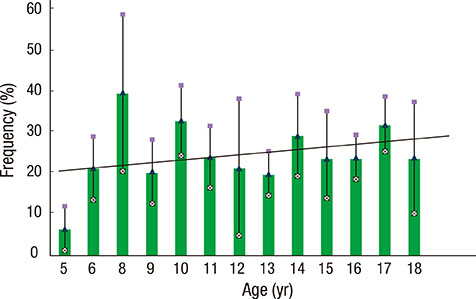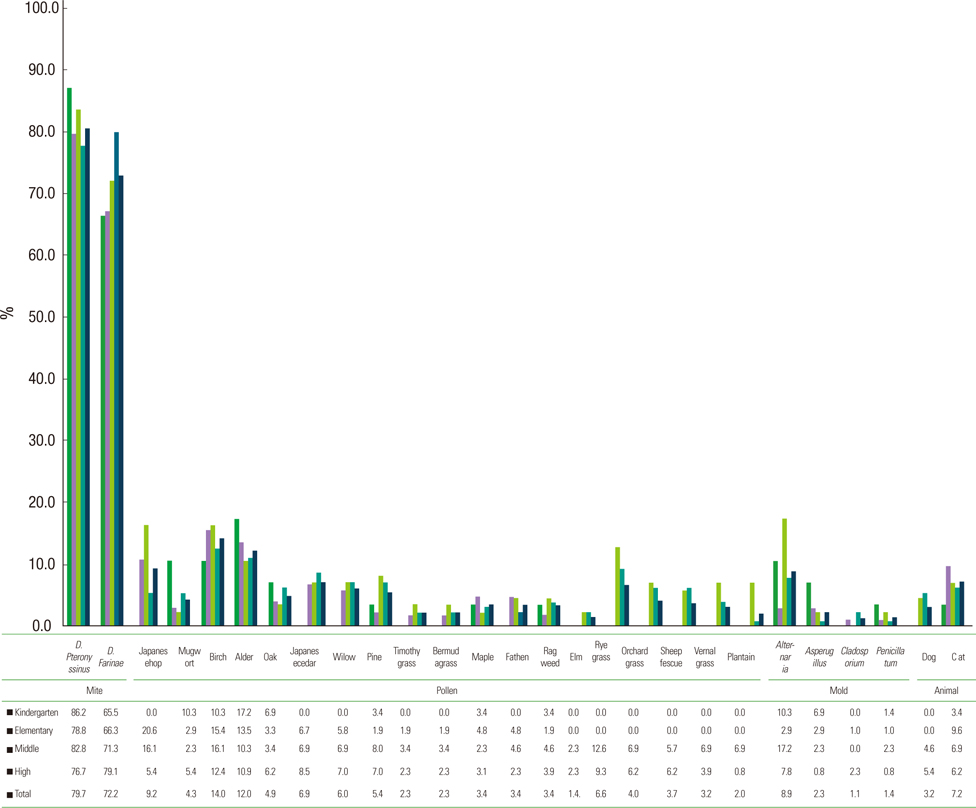Prevalence and allergens of allergic rhinitis in children and adolescents in Gwangju
- Affiliations
-
- 1Department of Pediatrics, Inha University School of Medicine, Incheon, Korea. dhnlim@naver.com
- 2Environmental Health Center for Allergic Rhinitis, Inha University Hospital, Incheon, Korea.
- 3Gwangju Mirae Children's Hospital, Gwangju, Korea.
- KMID: 2262278
- DOI: http://doi.org/10.4168/aard.2015.3.1.54
Abstract
- PURPOSE
Allergic rhinitis (AR) is one of the most common childhood diseases in Korea. In this study, we aimed to investigate the prevalence and allergens of childhood AR in Gwangju.
METHODS
From April 2013 to September 2013 in Gwangju, skin prick test and questionnaire survey were performed targeting 2,330 children in total (350 kindergartners, 930 elementary school students, 589 middle school students, and 461 high school students).
RESULTS
The overall prevalence of AR was 23.5% (female 21.3%, male 26.1%). According to age groups, prevalence of AR was 14.9% (female 10.7%, male 19.8%) in kindergartners, 24.5% (female 18.8%, male 29.4%) in elementary school students, 23.3% (female 18.1%, male 27.6%) in middle school students, 26.2% (female 27.7%, male 23.2%) in high school students. The most common allergen was Dermatophagoides pteronyssinus (79.7%), followed by Dermatophagoides farina (72.2%), birch (14.0%), alder (12.0%), Japanese hop (9.2%), Alternaria (8.9%), cat fur (7.2%), Japanese cedar (6.9%), ryegrass (6.6%), willow (6.0%), pine (5.4%), oak (4.9%), mugwort (4.3%), orchard grass (4.0%), sheep fescue (3.7%), fat hen (3.4%), ragweed (3.4%), and maple (3.4%).
CONCLUSION
This research figures out the prevalence and the detailed allergens of AR in Gwangju children. We suggest that more vegetation data of Japanese cedar should be surveyed in recent future.
Keyword
MeSH Terms
Figure
Cited by 4 articles
-
Allergic sensitization and its association with air pollution in childhood allergic rhinitis
Hyo-Bin Kim
Allergy Asthma Respir Dis. 2018;6(4):189-190. doi: 10.4168/aard.2018.6.4.189.Time trends of the prevalence of allergic diseases in Korea: A systematic literature review
Sung-Yoon Kang, Woo-Jung Song, Sang-Heon Cho, Yoon-Seok Chang
Asia Pac Allergy. 2018;8(1):. doi: 10.5415/apallergy.2018.8.e8.Relation of allergic rhinitis, allergen sensitization, and air pollutants in preschool children
Yoo-Jin Kim, Shin-Ae Yoon, Sung-Il Woo
Allergy Asthma Respir Dis. 2018;6(4):197-205. doi: 10.4168/aard.2018.6.4.197.Proper allergen selection for serum specific IgE test in children
Yong Ju Lee, Hyeon-Jong Yang, Jong-Seo Yoon, Man-Yong Han, Chang Keun Kim, Jin Tack Kim
Allergy Asthma Respir Dis. 2018;6(5):237-240. doi: 10.4168/aard.2018.6.5.237.
Reference
-
1. Nimmagadda SR, Evans R 3rd. Allergy: etiology and epidemiology. Pediatr Rev. 1999; 20:111–115.
Article2. Asher MI, Keil U, Anderson HR, Beasley R, Crane J, Martinez F, et al. International Study of Asthma and Allergies in Childhood (ISAAC): rationale and methods. Eur Respir J. 1995; 8:483–491.
Article3. Lee HB, Shin SA, Oh JW. New patterns of childhood asthma pevalence in six Asian countries: comparison of ISAAC phases I and III. Pediatr Allergy Respir Dis. 2008; 18:70–77.4. Asher MI, Montefort S, Bjorksten B, Lai CK, Strachan DP, Weiland SK, et al. Worldwide time trends in the prevalence of symptoms of asthma, allergic rhinoconjunctivitis, and eczema in childhood: ISAAC Phases One and Three repeat multicountry cross-sectional surveys. Lancet. 2006; 368:733–743.
Article5. Hong SJ, Ahn KM, Lee SY, Kim KE. The prevalences of asthma and allergic diseases in Korean children. Pediatr Allergy Respir Dis. 2008; 18:15–25.
Article6. Ahn K, Kim J, Kwon HJ, Chae Y, Hahm MI, Lee KJ, et al. The prevalence of symptoms of asthma, allergic rhinoconjunctivitis, and eczema in Korean children: nationwide cross-sectional survey using complex sampling design. J Korean Med Assoc. 2011; 54:769–778.
Article7. Jee HM, Kim KW, Kim CS, Sohn MH, Shin DC, Kim KE. Prevalence of asthma, rhinitis and eczema in Korean children using the International Study of Asthma and Allergies in Childhood (ISAAC) questionnaires. Pediatr Allergy Respir Dis. 2009; 19:165–172.8. Hong S, Son DK, Lim WR, Kim SH, Kim H, Yum HY, et al. The prevalence of atopic dermatitis, asthma, and allergic rhinitis and the comorbidity of allergic diseases in children. Environ Health Toxicol. 2012; 27:e2012006.
Article9. Lee HS, Lee J, Kim JW, Hong SC, Kim SY, Lee KH. The prevalence of allergic diseases in children living in Jeju. Pediatr Allergy Respir Dis. 2012; 22:248–255.
Article10. Kim DS, Park MR, Yu JS, Lee HS, Lee JH, Suh J, et al. Prevalence and risk factors of asthma and allergic rhinitis in elementary school children in Jinan-Gun. Pediatr Allergy Respir Dis. 2012; 22:374–382.
Article11. Kim TB, Kim KM, Kim SH, Kang HR, Chang YS, Kim CW, et al. Sensitization rates for inhalant allergens in Korea; a multi-center study. J Asthma Allergy Clin Immunol. 2003; 23:483–493.12. Bousquet J, Khaltaev N, Cruz AA, Denburg J, Fokkens WJ, Togias A, et al. Allergic Rhinitis and its Impact on Asthma (ARIA) 2008 update (in collaboration with the World Health Organization, GA(2)LEN and AllerGen). Allergy. 2008; 63:Suppl 86. 8–160.13. van Rijswijk JB, Blom HM, Fokkens WJ. Idiopathic rhinitis, the ongoing quest. Allergy. 2005; 60:1471–1481.
Article14. Okubo K, Kurono Y, Fujieda S, Ogino S, Uchio E, Odajima H, et al. Japanese guideline for allergic rhinitis. Allergol Int. 2011; 60:171–189.
Article15. Hwang SH, Jung SY, Lim DH, Son BK, Kim JH, Yang JM, et al. Epidemiology of allergic rhinitis in Korean children. Allergy Asthma Respir Dis. 2013; 1:321–332.
Article16. Suh M, Kim HH, Sohn MH, Kim KE, Kim C, Shin DC. Prevalence of allergic diseases among Korean school-age children: a nationwide cross-sectional questionnaire study. J Korean Med Sci. 2011; 26:332–338.
Article17. Osman M, Hansell AL, Simpson CR, Hollowell J, Helms PJ. Gender-specific presentations for asthma, allergic rhinitis and eczema in primary care. Prim Care Respir J. 2007; 16:28–35.
Article18. Seong HU, Cho SD, Park SY, Yang JM, Lim DH, Kim JH, et al. Nationwide survey on the prevalence of allergic diseases according to region and age. Pediatr Allergy Respir Dis. 2012; 22:224–231.
Article19. Kim JE, An HS, Kim MJ, Jung JA. A comparison of the sensitization rate to house dust mite in children with allergic disease in Busan's single university hospital in 2002 and 2007. Korean J Asthma Allergy Clin Immunol. 2009; 29:117–122.20. Park SH, Lim DH, Son BK, Kim JH, Song YE, Oh IB, et al. Sensitization rates of airborne pollen and mold in children. Korean J Pediatr. 2012; 55:322–329.
Article21. Yoon BJ, Kim SH, Kim DH, Koh YI. Longitudinal changes of sensitization rates to inhalant allergens in patients with allergic diseases from Gwangju and Chonnam areas: their association with annual changes in temperature. Korean J Asthma Allergy Clin Immunol. 2011; 31:93–104.22. Choi SW, Lee JH, Kim Y, Oh IB, Choi KR. Association between the sensitization rate for inhalant allergens in patients with respiratory allergies and the pollen concentration in Ulsan, Korea. Korean J Med. 2014; 86:453–461.
Article23. Choi HS, Cho JS, Choo JH, Ko WK, Ahn HY. Allergic rhinitis to Japanese Cedar in Cheju Island. Korean J Otolaryngol-Head Neck Surg. 1999; 42:1129–1133.24. Kim CS, Lee JS, Cho KJ. Biomass and net production of Cryptomeria japonica and Chamaecyparis obtusa plantation in Changsong district, Cheonnam. J Korea For Energy. 1987; 7:1–10.25. Hong HH, Jang JW, Sun EM, Kim BA, Kim SJ, Seo SR, et al. Floristic study of Mt. Mudeung. Korean J Environ Biol. 2013; 31:121–153.
Article26. Choi SW, Ju YS, Kim DS, Kim JY, Kwon HJ, Kang DH, et al. Reliability and validity of the Korean Version of ISAAC Questionnaire. Korean J Prev Med. 1998; 31:361–371.
- Full Text Links
- Actions
-
Cited
- CITED
-
- Close
- Share
- Similar articles
-
- Classification and Epidemiology of Allergic Rhinitis
- Prevalence of Allergic Rhinitis in China
- Comparison of Allergic Skin Prick Test and FAST System in Patients with Allergic Rhinitis
- Sensitization to Inhalant Allergens and Its Association with Allergic Diseases in Preschool Children
- Clinical Practice Guideline for Physicians on Allergic Rhinitis




